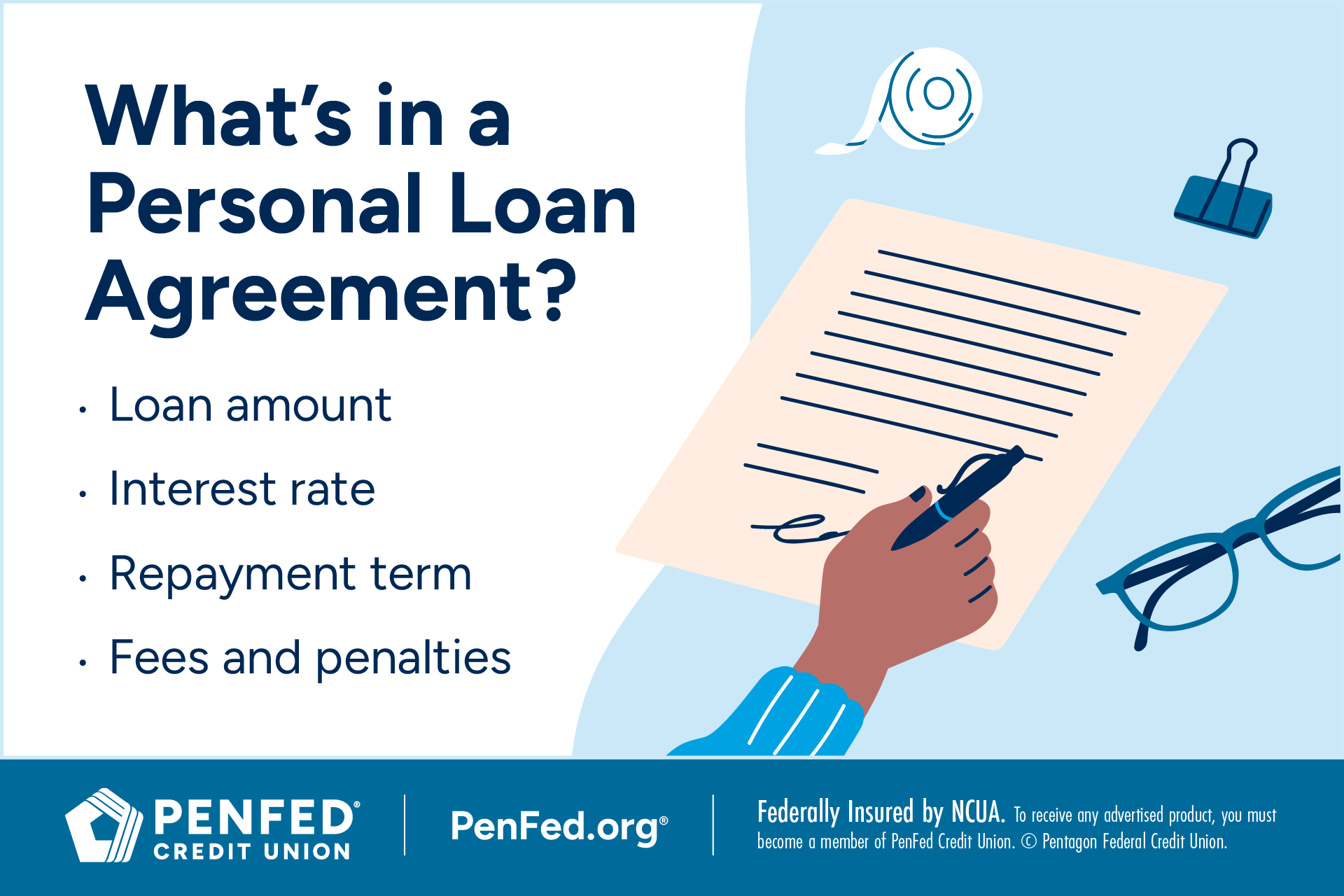PERSONAL LOAN
How to Read a Personal Loan Agreement
What You’ll Learn: How to read a personal loan agreement and understand its fees.
EXPECTED READ TIME: 6 MINUTES
A handshake may seal the deal when borrowing a few bucks from your buddy, but you'll need something a bit more formal to take out a loan with a traditional lender.
That's the role of a personal loan agreement, a small yet powerful document that ensures your promise to repay a debt is as good as gold.

What Is a Personal Loan Agreement?
A personal loan agreement is a written contract that you sign when borrowing money from a credit union, bank, or online lender, and in some cases, from a friend or family member. It serves as your promise to repay the personal loan and helps to protect both you and the lender if there's a disagreement or dispute.
Loan agreements are important for understanding the “rules” you agree to when you borrow money, such as how much you’re borrowing and how it will be repaid. Comparing loan agreements can also help you make more advantageous choices when you borrow.
What Information Will I Find in a Personal Loan Agreement?
Personal loan agreements contain important information about you and the lender, as well as details related to repaying the loan. Here are some of the main terms used in personal loan agreements:
Loan Amount
The sum of money you're borrowing from the lender. Limits for personal loans generally range from $1,000 to $100,000.
Interest Rate
The rate used to determine the amount of interest you must pay the lender to borrow money. Personal loan rates are calculated as a percentage of the loan amount using an annual percentage rate (APR).
If a potential lender wants you to pay an application fee, you should ask for it to be waived — or search for another loan partner.
Repayment Term
The length of time you have to pay back the loan, plus interest. Terms for personal loans range from 1-10 years, and payments are typically made in monthly installments.
Fees and Penalties
Costs the lender may charge as a condition of the loan or if certain aspects of the agreement are broken or not honored. Loan fees and penalties can include origination fees, prepayment penalties, late fees, application costs, and other charges.
Since personal loan agreements differ among lenders, your contract may include more information than these key components. For example, if you're taking out a secured personal loan, the agreement will list the collateral you're using to guarantee the loan and explain what could happen to the asset if you default.
Personal Loan Agreement Fees
In addition to standard terms and conditions, the loan agreement will outline required and optional fees you may have to pay.
Origination Fee
A personal loan origination fee is a one-time, up-front charge your lender may assess to process and underwrite your loan and pay out the funds. Origination fees commonly range from 1-5% — sometimes up to 10% — of the loan, depending on such factors as your credit score, the repayment term, the amount you're borrowing, and your income.
Not all lenders charge origination fees. Those who do usually deduct the amount from the loan amount. For instance, if you borrowed $5,000 with a 1% origination fee ($50), you'd receive $4,950 in loan proceeds.
Application Fee
Not to be confused with an origination fee, an application fee is a small, up-front cost (usually $25-50) some lenders charge to review your personal loan application. These fees are uncommon — or, perhaps more appropriately, unnecessary — so if a potential lender wants you to pay one, you should ask for it to be waived or search for another loan partner.
A prepayment penalty is an optional fee that some lenders impose if you pay off part or all of your loan before the term ends.
Late Payment Fee
A late payment fee is exactly what the name implies: a fine for failing to pay your monthly bill by the date specified in your loan agreement. Some lenders tack on a flat rate of $25-50 for late payments, while others charge 3-5% of the monthly payment amount.
If you incur a late payment fee, it should appear on the following month's statement. You can appeal the charge if there's a good reason your payment was delinquent, but there's no guarantee the lender will remove it. Either way, being consistently late with your payments will damage your credit score, which can impact your ability to borrow money in the future.
Prepayment Penalty
A prepayment penalty is an optional fee that some lenders impose if you pay off part or all of your loan before the term ends. Fees for early repayment are usually 2-5% of the original loan amount, although some lenders charge a flat fee or a period’s worth of interest (for example, 12 months’ worth).
Although it may seem counterintuitive to be penalized for paying back your loan ahead of schedule, it makes sense from the lender's perspective.
Lenders make their money on monthly interest charges, so if you reduce the number of payments they receive, you're effectively cutting their profit. Prepayment penalties help the lender recoup some or all of the interest charges they'd otherwise lose if you pay your loan off early.
If you incur a late payment fee, it should appear on the following month's statement.
Non-sufficient Funds Fee
Commonly known as a returned check fee, a non-sufficient funds (NSF) fee is a penalty most lenders assess when you try to pay your bill using an account that doesn't have enough cash in it to cover the entire payment. NSF fees, which are usually around $32, help your lender cover the costs of processing a check (or electronic payment) that wasn't valid.
For instance, if you write a $550 check for your monthly loan payment and only have $450 in your account, the check will "bounce." Since the lender won't be able to complete the transaction, they'll charge an NSF fee — on top of any penalties your credit union or bank may impose — for their time and inconvenience. Chances are good your lender will also assess a late payment penalty because they didn't receive your payment by the due date.
How to Avoid Personal Loan Agreement Fees
The best way to avoid paying personal loan fees is to look for a lender that doesn't charge them. Although you probably won't find a creditor who waives penalties for late payments and insufficient funds, most other fees are negotiable. Some lenders even specialize in no-fee loans.
Keep in mind that interest rates may be higher on low- or no-fee products. On the other hand, lenders that offer lower interest rates may charge more fees to make up the difference.
When weighing your options, ask potential lenders for a full schedule of fees and the exact amounts of each charge. This information, combined with the APR of each loan, will allow you to calculate monthly loan payments and compare alternatives more accurately.
FAQs
What Is the Structure of a Typical Personal Loan Agreement?
Personal loan agreements usually contain the following types of information:
Full names and contact information of the borrower and lender
Loan details such as the principal loan amount, interest rate, APR, and term
Repayment schedule, including payment due dates, payment amount per installment, and payment method (such as check or bank transfer)
Descriptions of any collateral (if applicable)
Fees, their amounts, and when they will apply
Default provisions the lender can take if the borrower misses payments, such as imposing fees
Dispute resolution process for any disagreements between the borrower and lender
Signatures of the borrower and lender indicating they agree to everything in the loan agreement document
How Soon Do You Have to Start Paying Back a Personal Loan?
Most personal loans require you to start repaying your loan within 30 days. Your lender will specify your first payment due date in your personal loan agreement.
Do You Have to Tell a Lender What a Personal Loan Is for?
Loan applications for banks, credit unions, and online lenders often require you to disclose your purpose for taking out a personal loan. It’s common for their loan applications to include a drop-down list of general purposes such as debt consolidation or home renovation.
Disclosing what your personal loan is for can impact the amount, terms, and interest rate you receive. While personal loans can be used for almost anything, some lenders do have restrictions on how their loans can be used. For example, if a lender specializes in debt consolidation loans, then they may reject your application for a loan to cover your wedding.
Your purpose for borrowing can also impact your repayment term and interest rate. Some lenders decide loan terms based purely on the loan amount, term, and your creditworthiness. Others may offer higher borrowing amounts and longer terms for some purposes (like home improvement or IVF) than others (such as a family vacation). They may also charge higher interest for some purposes, such as debt consolidation.
The Takeaway
At the end of the day, personal loan agreements — and the fees that often come with them — are legally binding arrangements that can impact your financial well-being for years to come.
So, before you put pen to paper, make time to understand exactly what you're signing and why. It's the first step to fulfilling your future obligations and proving your pledge is more than words.
Learn More About Personal Loan Options at PenFed
Discover the diverse offering of products, services, and support available to our members.




